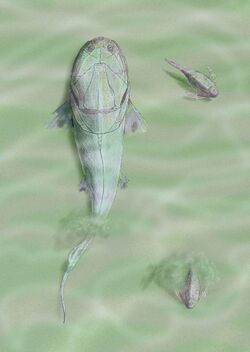Biology:Homostiidae
| Homostiidae | |
|---|---|

| |
| Homosteus milleri | |
| Scientific classification | |
| Domain: | Eukaryota |
| Kingdom: | Animalia |
| Phylum: | Chordata |
| Class: | †Placodermi |
| Order: | †Arthrodira |
| Suborder: | †Brachythoraci |
| Family: | †Homostiidae Jaekel, 1903 |
| Type species | |
| Homosteus formosissimus Asmuss, 1856
| |
| Genera | |
| |
| Synonyms | |
Homostiidae (alternatively spelled Homosteidae) is a family of flattened arthrodire placoderms from the Early to Middle Devonian. Fossils appear in various strata in Europe, Russia , Morocco, Australia , Canada and Greenland.
Homostiids have flattened and elongated skulls, "toothless" jaws and large sizes, suggesting that many were probably filter feeders, similar to the noticeably flattened whale shark.[2][3][4][5] According to Denison 1978, primitive homostiids have moderately long median dorsal plates, whereas in "advanced" homostiids, the median dorsal tends to be short and broad.[1]:69
Classification
The family Homostiidae is considered the basal-most grouping within the suborder Brachythoraci, basal to the large sub-clade Eubrachythoraci, which includes the well-known Dunkleosteus, Dinichthys, etc. Homostiidae's placement within Brachythoraci can be shown in the cladogram below:[6]
| Brachythoraci |
| |||||||||||||||||||||||||||||||||||||||||||||||||||||||||||||||||||||||||||
Genera
Angarichthys
A comparatively large animal from the Middle Devonian of Siberia, with a head shield estimated around 40 centimeters long. Known only from an infragnathal bone, and an intero-lateral and a marginal plate.
Antineosteus
A primitive homostiid from Emsian-aged strata of Morocco. Antineosteus' primitive anatomical features suggest it may be a precursor to Angarichthys, Atlantidosteus and Homosteus. Antineosteus lived sympatrically with the Moroccan species of Atlantidosteus.
Atlantidosteus
This genus is known from species found in Emsian-aged Morocco and Middle Devonian Australia. Overall form is very similar to Antineosteus and Homosteus.
Cavanosteus
A primitive genus from Emsian-aged strata of Australia
Cathlesichthys
A genus of homostiid from Wee Jasper, living during the Early Devonian.
Euleptaspis
This genus is known from isolated plates and fragments from Lower Devonian-aged strata in Spitzbergen and Germany . The holotype of the type species, E. depressa, is a paranuchal plate very similar to those seen in coccosteids.
Dhanguura?
A very large, primitive form from the Early Devonian Taemas-Wee Jasper Reef fauna. Its discoverer, Gavin Young, hypothesizes that it may have been a filter-feeder.
Homosteus
The type genus, known from both complete and fragmentary fossils in Europe, Russia, and North America.
Lophostracon
Luetkeichthys
Tityosteus
Tityosteus is thought to be the largest vertebrate known from the Lower Devonian, with an estimated length of 2.5 meters. The holotype is an incomplete individual from the Hunsrück.[1]:73
References
- ↑ Jump up to: 1.0 1.1 1.2 Handbook of Paleoichthyology. 2: Placodermi. Stuttgart New York: Gustav Fischer Verlag. 1978. ISBN 978-0-89574-027-4.
- ↑ "Před 400 milióny lety u nás žili gigantičtí obratlovci" (in Czech). National Museum News. 4 December 2014. http://muzeum3000.nm.cz/veda/pred-400-miliony-lety-u-nas-zili-giganticti-obratlovci.
- ↑ "The largest Lower Devonian placoderm-Antineosteus rufus sp. nov. from the Barrandian area (Czech Republic).". Bulletin of Geosciences 89 (3): 635–644. 2014. http://www.geology.cz/bulletin/fulltext/1450_Vaskaninova.pdf.
- ↑ "Fish from the Emsian of Aragón". 2006.
- ↑ "Was the Devonian placoderm Titanichthys a suspension feeder?". Royal Society Open Science 7 (5): 200272. May 2020. doi:10.1098/rsos.200272. PMID 32537223. Bibcode: 2020RSOS....700272C.
- ↑ Zhu, You-An; Zhu, Min; Wang, Jun-Qing (1 April 2016). "Redescription of Yinostius major (Arthrodira: Heterostiidae) from the Lower Devonian of China, and the interrelationships of Brachythoraci". Zoological Journal of the Linnean Society 176 (4): 806–834. doi:10.1111/zoj.12356. ISSN 0024-4082.
Wikidata ☰ Q16983286 entry
 |

